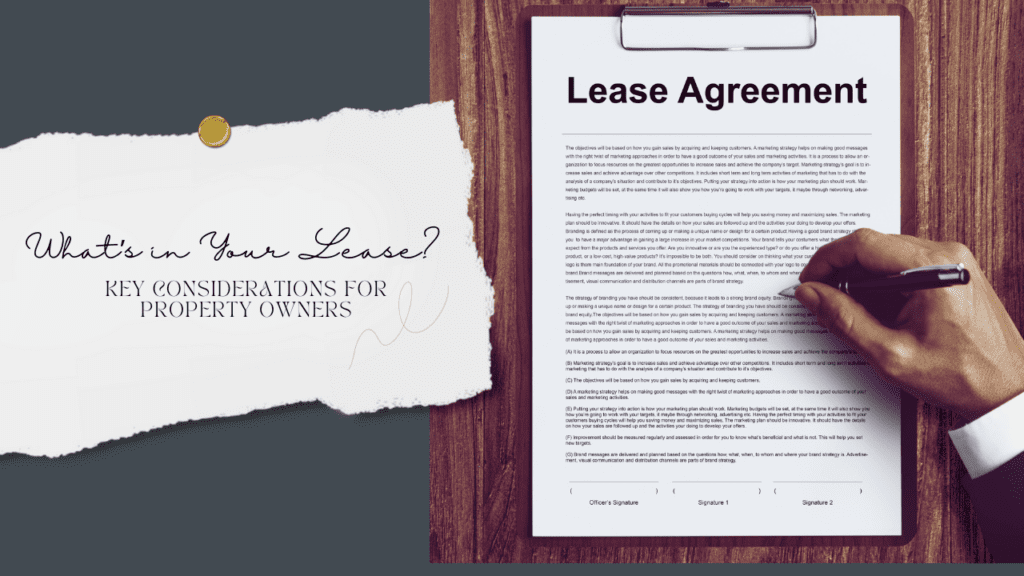
Lease agreements are always important documents between landlords and tenants. In California, your lease agreement is especially important. This is a state with a lot of laws and tenant protections that need your attention. A good lease is the best way to protect yourself and your rental property.
A lease agreement is always considered to be the foundation of a landlord-tenant relationship. Your well-drafted lease agreement will be both legally enforceable and legally compliant. A good lease outlines the responsibilities of both tenants and landlords. It lists obligations and sets expectations.
As a landlord, you need to create a comprehensive California lease agreement to avoid any confusion or legal disputes.
We’ve been managing properties in the South Bay for years, and we can help you ensure that your lease agreement includes everything it needs to.
Here’s how you can use your lease agreement to prevent conflicts and ensure a smooth and peaceful tenancy.
Contact Information and Names of Tenants and Landlord
The lease must explicitly state the names of the landlord or the person who owns the rental home. You’ll also need all of the names of the tenants who are authorized to reside in the property. Include contact information for all parties, including phone numbers, email addresses, and mailing addresses. Ask for an emergency contact and include that contact information as well. You’ll need this information for communication purposes throughout the tenancy.
If your property is being professionally managed, the lease agreement must include the name and contact information of your property management company. This will be the point of contact for tenants if they have a question or if something goes wrong.
Document Rent Collection Policies and Collected Security Deposit Amount
Your lease needs to include the total amount owed in rent – on a monthly basis and in its entirety for the entire term of the lease. Make sure you include your complete rent collection policy, including:
- The amount that’s due
- When the rental payment is due
- How rent should be paid
- Whether there are grace periods or late fees and other consequences for late rent
Include information on the security deposit you collect, including the amount, the purpose of that deposit, and what will be necessary in order for tenants to get that full amount refunded at the end of the lease term. You can also indicate where the deposit is being held.
When you’re talking about rent and deposits, make sure to reference any other payments that may be necessary before move-in, such as pet fees.
Term of Lease
The agreement should cover the lease duration, the process for renewing the lease, and any termination clauses that need to be included. You want to make sure the lease is clear on the move-in and move-out dates. Tenants will need to know what happens at the end of the lease – does it automatically renew? Is a new lease signed? Do you simply convert to a month-to-month situation? How much notice has to be given if a tenant decides to move out?
Maintenance Procedures and Responsibilities
Maintenance will be one of the most significant issues for you as you rent out a property. Use your lease agreement to lay out specific procedures for reporting maintenance and repair needs.
This section of your lease should also specify the acceptable use of the property. You’ll want to state circumstances where you can enter the tenant’s home to make repairs or respond to emergencies.
Discuss who is responsible for things like landscaping and lawn care. If you want your tenant to be responsible for things like air filter changes and lawn mowing, mention it in the lease.
This is where you want to prohibit making changes to the property. If you don’t want the tenant to paint the walls or bring in their own appliances, this is where you reference that.
Rules and Regulations
Your lease should be clear about what’s allowed and what’s not allowed. If you don’t want smoking inside or even outside of the property, make sure the lease states that. You can include restrictions on guests, parking, and pets. An entire pet policy should be included as an addendum if you are allowing dogs and cats. Every lease should forbid criminal activity of any kind.
When your rental property is in an HOA, there will be an additional list of rules and regulations. Make sure your tenant receives a copy of those and understands the importance of following the rules and requirements. Otherwise, you’ll be faced with a fine from your HOA.
Legal Disclosures and Clauses in California Lease Agreements
 California lease agreements must include legal clauses to comply with federal, state, and local laws. These disclosures and disclaimers address tenant rights, non-discrimination policies, and eviction processes.
California lease agreements must include legal clauses to comply with federal, state, and local laws. These disclosures and disclaimers address tenant rights, non-discrimination policies, and eviction processes.
Rent control is now in place across the state. If your property is exempt from the rent control laws, you have to reference this in your lease agreement. Properties that are fewer than 15 years old or single-family homes and condos are typically exempt from rent control laws included in The Tenant. Protection Act. However, your lease needs to state that you’re exempt, otherwise, you do have to follow rent control laws.
This is a high-level overview of what your lease agreement absolutely must include. There’s a lot more that goes into a lease agreement, and that’s why it’s so important that you work with a local property management company in the South Bay to get your property rented properly. You don’t want to download any lease template that you find online. There are specific languages that are necessary in your California lease. If you don’t have a property management partner, contact us. Or, get a lease agreement from a trusted organization like the California Association of Realtors or the California Apartment Association.
Your lease agreement is the most important document you’ll sign as a landlord. Let us help.
Please contact us at South County Property Management. We serve Santa Clara County and South County, including San Jose, Campbell, Saratoga, Cupertino, Sunnyvale, Los Gatos, Milpitas, Morgan Hill, Gilroy, and neighboring areas.
